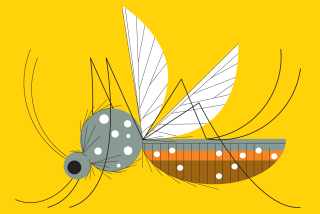Researchers engineer malaria-proof mosquitoes
- Share via
Malaria kills nearly 1 million people a year, but it has a weakness — to infect humans, it needs mosquitoes. In a potential step toward eradicating the disease, researchers report that they have developed a genetically engineered breed of mosquito that cannot be infected by the malaria-causing parasite.
Genetically-modified mosquitoes are far from ready for use in the field, but the researchers achieved an unprecedented 100% blockage of the Plasmodium parasite, highlighting the promise of this approach, according to their study.
The team, led by entomologist Michael Riehle at the University of Arizona, created the mosquitoes by changing a single gene, one involved in the production of insulin. To test the effect of that change, researchers injected 90 of the mosquitoes with the malaria parasite. Ten days later, at a point when normal mosquitoes would have bellies full of parasites, they didn’t find a single one.
This is the first instance of a genetic modification that completely blocked development of a malaria parasite that can infect humans. The research was reported online this week in the journal PLoS Pathogens.
“We were just hoping to see any reduction,” Riehle said. “We were pretty shocked that it was that great.”
Total blockage is not only impressive, it’s biologically crucial. Other groups have achieved 90% to 95% blockage by combining various genetic alterations, but such less-than-perfect protection could allow the parasite to evolve around the mosquito’s blocking mechanism, in much the same way that drug-resistant bacteria can arise if antibiotic treatments aren’t completed.
The researchers used a slightly modified version of a cellular signaling gene that already exists in mosquitoes. That signaling process influences the mosquito’s life span, as well as its immune response. By targeting this gene, they were aiming to create insects that died young so that the malaria parasite didn’t have the 16 days in the mosquito gut it needs to mature.
It worked — the mosquitoes on average lived about 20% shorter lives than normal mosquitoes. The complete blockage of the parasite development was an unexpected bonus. The researchers don’t yet understand how the genetic change makes the mosquitoes malaria-proof.
Despite this genetic engineering success, there are two main hurdles before such mosquitoes could be used to reduce malaria infections. First, the modified gene would have to spread throughout the entire mosquito population. Normally, this would occur only if the gene provided a great evolutionary advantage, but these malaria resistance genes don’t have that effect.
“It’s like a train,” said Mark Benedict, a medical entomologist and consultant for the Centers for Disease Control and Prevention. “You’ve got to have a car — that’s the gene — but you’ve got to have an engine as well.” The engine could be provided by connecting the gene to a piece of DNA that helps it spread by, for example, producing something that kills any mosquitoes that don’t contain the desired gene. Other research groups are working to develop such clever genetic tricks, but they are still years away from implementation.
It is also possible that releasing an engineered flying insect into the environment could prove damaging to other plants and animals. Before researchers could undertake any field trials, they would need to do extensive safety testing.
Riehle suspects that, in time, researchers will perfect their ability to effectively use genetically modified mosquitoes and that governments and public health organizations will work together to deploy them. However, experts agree that such an approach is at least 10 years away, if not 20 or more.
Even so, researchers are optimistic that genetic engineering of mosquitoes will be an important piece of the malaria-prevention puzzle.
“The investment is well worth it,” Benedict said. “The power to affect human health in a positive way is tremendous.”
Vaccines are also expected to be a crucial part of the malaria-fighting effort. A two-pronged approach that targets both disease-transmitting mosquitoes, perhaps via genetic engineering, and susceptible human populations, probably by vaccines, will probably be required for eventual eradication of the disease.
“We definitely don’t imagine this to be the magic bullet,” Riehle said of his mosquito, “but it’s another tool in the toolbox.”






